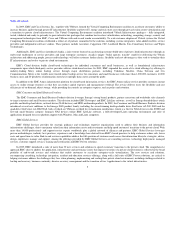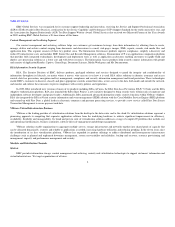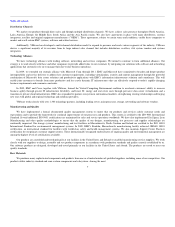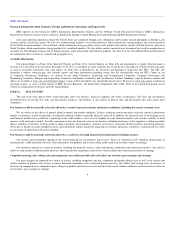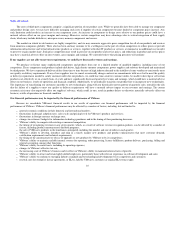EMC 2009 Annual Report Download - page 16
Download and view the complete annual report
Please find page 16 of the 2009 EMC annual report below. You can navigate through the pages in the report by either clicking on the pages listed below, or by using the keyword search tool below to find specific information within the annual report.
Table of Contents
claims, and governmental and other regulatory investigations and proceedings. Such matters can be time-consuming, divert management's attention and
resources and cause us to incur significant expenses. Furthermore, because litigation is inherently unpredictable, there can be no assurance that the results of
any of these actions will not have a material adverse effect on our business, results of operations or financial condition.
We may have exposure to additional income tax liabilities.
As a multinational corporation, we are subject to income taxes in both the United States and various foreign jurisdictions. Our domestic and
international tax liabilities are subject to the allocation of revenues and expenses in different jurisdictions and the timing of recognizing revenues and
expenses. Additionally, the amount of income taxes paid is subject to our interpretation of applicable tax laws in the jurisdictions in which we file and changes
to tax laws. From time to time, we are subject to income tax audits. While we believe we have complied with all applicable income tax laws, there can be no
assurance that a governing tax authority will not have a different interpretation of the law and assess us with additional taxes. Should we be assessed with
additional taxes, there could be a material adverse effect on our results of operations or financial condition.
The renewal of the U.S. research and development tax credit which benefited our tax rate by approximately 3 percentage points in 2009 is uncertain
from year to year. It currently is repealed for 2010.
In January 2010, the IRS announced its intent to require certain taxpayers to disclose uncertain tax positions (UTPs) on a new schedule as a part of their
federal tax returns. The schedule will require annual disclosure of some UTPs in the form of a concise description of those positions and the maximum
exposure attributable to each position. If implemented, such proposal could increase the amount of taxes paid.
In February 2010, President Obama, as part of the Administration's FY 2011 budget, proposed changing certain of the U.S. tax rules for U.S.
corporations doing business outside the United States. The proposed changes include limiting the ability of U.S. corporations to deduct certain expenses
attributable to offshore earnings, modifying the foreign tax credit rules and taxing currently certain transfers of intangibles offshore. Although the scope of the
proposed changes is unclear, it is possible that these or other changes in the U.S. tax laws could increase the Company's effective tax rate and adversely affect
our profitability.
Changes in regulations could materially adversely affect us.
Our business, results of operations or financial condition could be materially adversely affected if laws, regulations or standards relating to us or our
products are newly implemented or changed. In addition, our compliance with existing regulations may have a material adverse impact on us. Under
applicable federal securities laws, including the Sarbanes-Oxley Act of 2002, we are required to evaluate and determine the effectiveness of our internal
control structure and procedures for financial reporting. Should we or our independent auditors determine that we have material weaknesses in our internal
controls, our results of operations or financial condition may be materially adversely affected or our stock price may decline.
Changes in generally accepted accounting principles may adversely affect us.
From time to time, the Financial Accounting Standards Board (FASB) either alone or jointly with the International Accounting Standards Board (IASB)
promulgates new accounting principles that could have a material adverse impact on our results of operations or financial condition. For example, in May
2008, the FASB voted to issue authoritative guidance which changed the accounting treatment for certain convertible securities which include our Notes. See
Note B to our Consolidated Financial Statements.
In addition, in 2007, the FASB issued authoritative guidance on business combinations. This guidance, which was effective commencing in our 2009
fiscal year, resulted in significant changes in accounting for acquisitions, including our recently completed acquisition of Data Domain, Inc. Depending upon
the number of and magnitude of acquisitions which we may consummate in 2010, this guidance could have a material adverse effect on our business, results
of operations or financial condition.
Our business could be materially adversely affected as a result of the risks associated with acquisitions and investments.
As part of our business strategy, we seek to acquire businesses that offer complementary products, services or technologies. These acquisitions are
accompanied by the risks commonly encountered in an acquisition of a business, which may include, among other things:
• the effect of the acquisition on our financial and strategic position and reputation;
• the failure of an acquired business to further our strategies;
15


